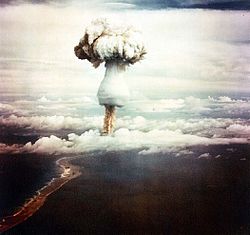- Operation Greenhouse
-
Operation Greenhouse 
Greenhouse GeorgeInformation Country United States Test site Pacific Proving Grounds Period April - May 1951 Number of tests 4 Test type Atmospheric tests Device type Fission/Thermonuclear Max. yield 225 kilotons of TNT (940 TJ) Navigation Previous test Operation Ranger Next test Operation Buster-Jangle The George shot.
Operation Greenhouse was the fifth American nuclear test series, the second conducted in 1951 and the first to test principles that would lead to developing thermonuclear weapons (hydrogen bombs). Conducted at the new Pacific Proving Ground, all of the devices were mounted in large steel towers, to simulate air bursts. This series of nuclear weapons tests were preceded by Operation Ranger and succeeded by Operation Buster-Jangle.
Operation Greenhouse represented new and aggressive designs for nuclear weapons. The main idea was to reduce the size, weight, and most importantly, reduce the amount of fissile material necessary for nuclear weapons, while increasing the destructive power. With the Soviet Union's first nuclear test a year and half earlier, the United States had begun stockpiling the new designs before they were actually proven. Thus the success of Operation Greenhouse was vital before the development of thermonuclear weapons could continue.
A number of target buildings, including bunkers, homes and factories were built on Mujinkarikku Islet to test nuclear weapon effects.
The "George" explosion was the world's first thermonuclear burn, though it was just a test design, unsuitable for weaponization. Shaped like a torus, the "George Device" had a small amount of heavy isotopes of liquid hydrogen (deuterium and tritium) placed at its center. The vast majority of its yield derived from fission. The energy output from the thermonuclear fusion in this test was insignificant in comparison. The "George" test was actually that of a "boosted" atomic bomb. The small amount of heavy deuterium and tritium in this test fused, but its role was to generate a strong flurry of fast neutrons - ones that sparked more fissions in the uranium nuclei that were present, and which also caused fission in uranium-238 - which does not fission under bombardment with slow neutrons, as does uranium-235.
However, the "George" test validated the principles which would be used for the first full-scale thermonuclear bomb test, Ivy Mike, one year later, on 1 November 1952, at Eniwetok Atoll. "Greenhouse Item" was the first boosted fission weapon, nearly doubling the normal yield of a similar non-boosted weapon.
Greenhouse Test Blasts Test Name Date Location Yield Note Dog 8 April 1951 Pacific Proving Ground 70 kilotons Easy 21 April 1951 Pacific Proving Ground 47 kilotons George 9 May 1951 Pacific Proving Ground 225 kilotons First thermonuclear experiment, deuterium core Item 25 May 1951 Pacific Proving Ground 45.5 kilotons First bomb with tritium "boosting" See also
Literature
- Magdi Ragheb: Nuclear, Plasma and Radiation Science – Inventing the future (Web Text), Part I, Chapter 5 (2009): Race for the Super.
Categories:- American nuclear explosive tests
- 1951 in military history
- Enewetak Atoll
Wikimedia Foundation. 2010.


